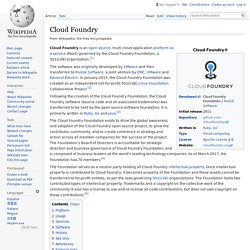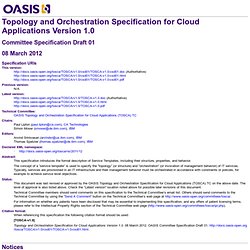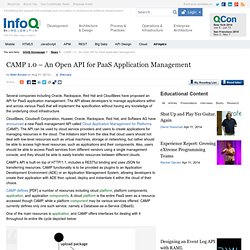

ElasticBox. Inspecting the PaaS Landscape. There has been a lot of press around the notion of Platform as a Service (PaaS). It seems like a week doesn't go by without an announcement about a PaaS platform. In this article, I will try to explore the various types of PaaS platforms and distinguish between them. Cloudfoundry/bosh. Home » OpenStack Open Source Cloud Computing Software. Open Source Cloud Computing. Tableau de bord - CloudStack. CloudStack Project Incubation Status. This page tracks the project status, incubator-wise.

For more general project status, look on the project website. The CloudStack project graduated on 2013-03-20 CloudStack is an IaaS (“Infrastracture as a Service”) cloud orchestration platform. link to the main website link to the page(s) that tell how to participate (Website,Mailing lists,Bug tracking,Source code) link to the project status file (Committers,non-incubation action items,project resources, etc) If the project website and code repository are not yet setup, use the following table: January 2013. The Open Source Cloud Broker. Welcome to Cloud Foundry. Cloud Foundry. Cloud Foundry is an open source, multi cloud application platform as a service (PaaS) governed by the Cloud Foundry Foundation, a 501(c)(6) organization.[1] The software was originally developed by VMware and then transferred to Pivotal Software, a joint venture by EMC, VMware and General Electric.

In January 2015, the Cloud Foundry Foundation was created as an independent not-for-profit 501(c)(6) Linux Foundation Collaborative Project.[2] The Cloud Foundry Foundation exists to drive the global awareness and adoption of the Cloud Foundry open source project, to grow the contributor community, and to create coherence in strategy and action across all member companies for the success of the project. The Foundation’s Board of Directors is accountable for strategic direction and business governance of Cloud Foundry Foundation, and is composed of business leaders at the world’s leading technology companies.
As of March 2017, the Foundation has 70 members.[4] Platform[edit] Usage[edit] Deploying vert.x Applications to Cloud Foundry. NOTE: Modified to use 0.8.2 version of cloudfoundry-runtime dependency together with the 1.2.3.final version of vert.x (Jan 2, 2013) Developers can now use vert.x, a framework for highly scalable web applications, with CloudFoundry.com.

Cloud Foundry has been a leader in providing an open Platform as a Service (PaaS), which allows for polyglot programming with a choice of multiple languages and frameworks. With recent releases of standalone application feature and Java 7 on CloudFoundry.com, developers now have a perfect environment to create vert.x applications, which can be written in any language that can run on the Java Virtual Machine (JVM), and deploy them to run on the JVM at CloudFoundry.com. About vert.x vert.x is a framework that builds on event-driven architecture and asynchronous I/O, similar to Node.js, but utilizes JVM’s internal capabilities to handle multiple processes and inter-process communications. Running vert.x Applications on CloudFoundry.com $ . Heroku. OASIS TOSCA Specification. IT services (or just services in what follows) are the main asset within IT environments in general, and in cloud environments in particular.

The advent of cloud computing suggests the utility of standards that enable the (semi-) automatic creation and management of services (a.k.a. service automation). These standards describe a service and how to manage it independent of the supplier creating the service and independent of any particular cloud provider and the technology hosting the service. CAMP 1.0 – An Open API for PaaS Application Management. Several companies including Oracle, Rackspace, Red Hat and CloudBees have proposed an API for PaaS application management.

The API allows developers to manage applications within and across various PaaS that will implement the specification without having any knowledge of the underlying cloud infrastructure. CloudBees, Cloudsoft Corporation, Huawei, Oracle, Rackspace, Red Hat, and Software AG have announced a new PaaS management API called Cloud Application Management for Platforms (CAMP). The API can be used by cloud service providers and users to create applications for managing resources in the cloud.
The initiators start from the idea that cloud users should not deal with low-level resources such as virtual machines, storage or networking, but rather should be able to access high-level resources, such as applications and their components. CAMP’s API is built on top of HTTP/1.1, includes a RESTful binding and uses JSON for transferring resources. Comparing Amazon's and Google's Platform-as-a-Service (PaaS) Offerings.
The announcement this week that Google released a beta version of a robust cloud computing platform called Google App Engine that lets anyone build apps on Google's renowned and highly scalable infrastructure underscored a key trend in the software industry today.

Namely that software platforms are moving from their traditional centricity around individually owned and managed computing resources and up into the "cloud" of the Internet. Google's entry into a space that has been largely dominated so far by Amazon and its Elastic Compute Cloud -- as well as a few smaller players like Bungee and Heroku -- has turned the Internet cloud computing space into a fully-fledged industry virtually overnight. Figure 1: Amazon and Google both offer comprehensive PaaS solutions This takes us to the capabilities of these platforms, which are just now being fully fleshed out and offered to the marketplace in a form that's relatively complete (though we'll see which pieces are still missing in a minute.) PaaS definition (Wikipedia)